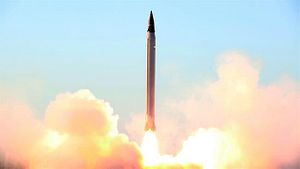Iranian Defense Minister Brigadier General Hossein Dehqan rejected a claim made by Deputy Chief of Staff of the Iranian Armed Forces, Brigadier General Ali Abdollahi, on Monday that Iran test-fired a ballistic missile with a range of 2,000 kilometers (1,242 miles) and a margin of error of eight meters in April, according to Fars News Agency.
“We haven’t recently tested any missile with the range of 2,000km and with an 8-meter-margin of error,” Dehqan told reporters earlier in the week. Iran’s defense minister, however, emphasized that the development of the country’s missile program will never stop.
Brigadier General Abdollahi announced the missile test on Monday during a conference at Baghiatollah Hospital in Tehran, an affiliate of the Islamic Revolutionary Guards Corps.
“Two weeks ago, we test-fired a missile with a range of 2000 kilometers (1,242 miles) and a margin of error of eight meters,” Abdollahi said. “Eight meters means nothing, it means it’s without any error (…). We can guide this ballistic missile,” Abdollahi boasted.
U.S. officials were not sure what to make of the conflicting reports. “We’re still trying to get to the bottom of what exactly transpired,” White House spokesman Josh Earnest said during a press conference. “We are aware of Iranian claims of an additional ballistic missile launch … we’re also aware of statements from the defense minister indicating that such a launch did not take place.”
“We are aware of Iranian comments on an additional ballistic missile launched,” State Department spokeswoman Elizabeth Trudeau said on Monday. “We remained concerned about Iran’s ballistic missile test launches which are provocative and destabilizing.” In October 2015, Tehran purportedly test-fired the Emad (Pillar), a single-stage, liquid-propelled medium-range ballistic missile. In March, the Iranian Revolutionary Guard Corps launched two Qadr ballistic missiles. (One of the missiles had the phrase “Israel must be wiped out” written in Hebrew on it.)
As I noted earlier, “Abdollahi’s announcement has to be put into context with exaggerated Iranian claims of successful missile tests in the past and should be met with a dose of skepticism, particularly since the recent test cannot be verified independently.” A study by the Center for Strategic and International Studies further explains:
Iran has not conducted extensive, realistic missile tests at full operational ranges and carried through to strikes on target with the same configuration of its modified or Iranian-produced missiles to make reliable estimates of their war fighting capability.
Additionally, “Iran has a tendency to introduce similar missiles under different names, exaggerate missile performance, exaggerate the number of missiles used in tests, and actively doctor reports of firings and their results.”
“Some of the more dangerous missiles in Iran’s inventory are the solid-fueled Fateh-110, the liquid-fueled BM-25 medium-range ballistic missile (MRBM), and the still-under-development two-stage solid fueled Ashoura MRBM,” I explained. Iran possesses one of the largest ballistic missile forces in the Middle East.
































